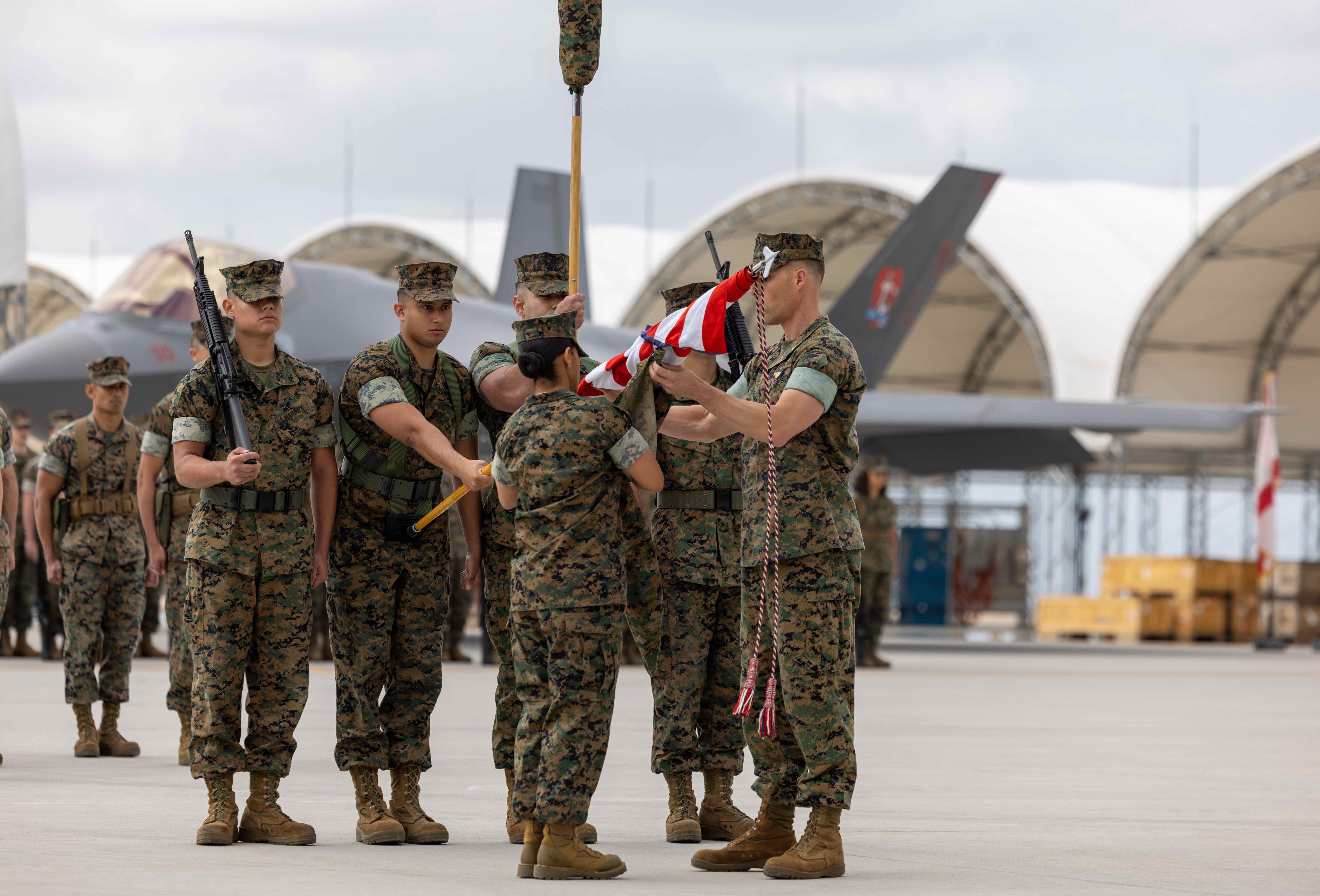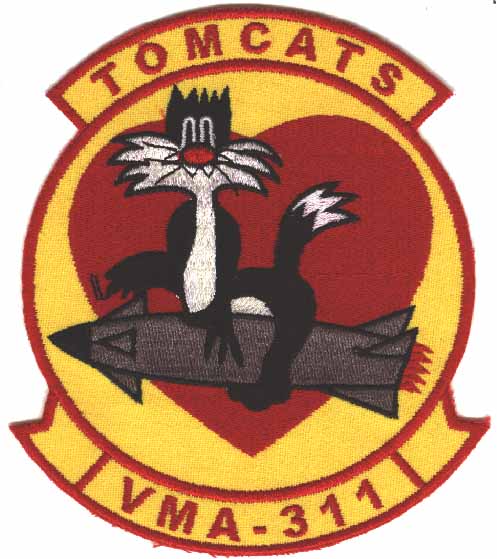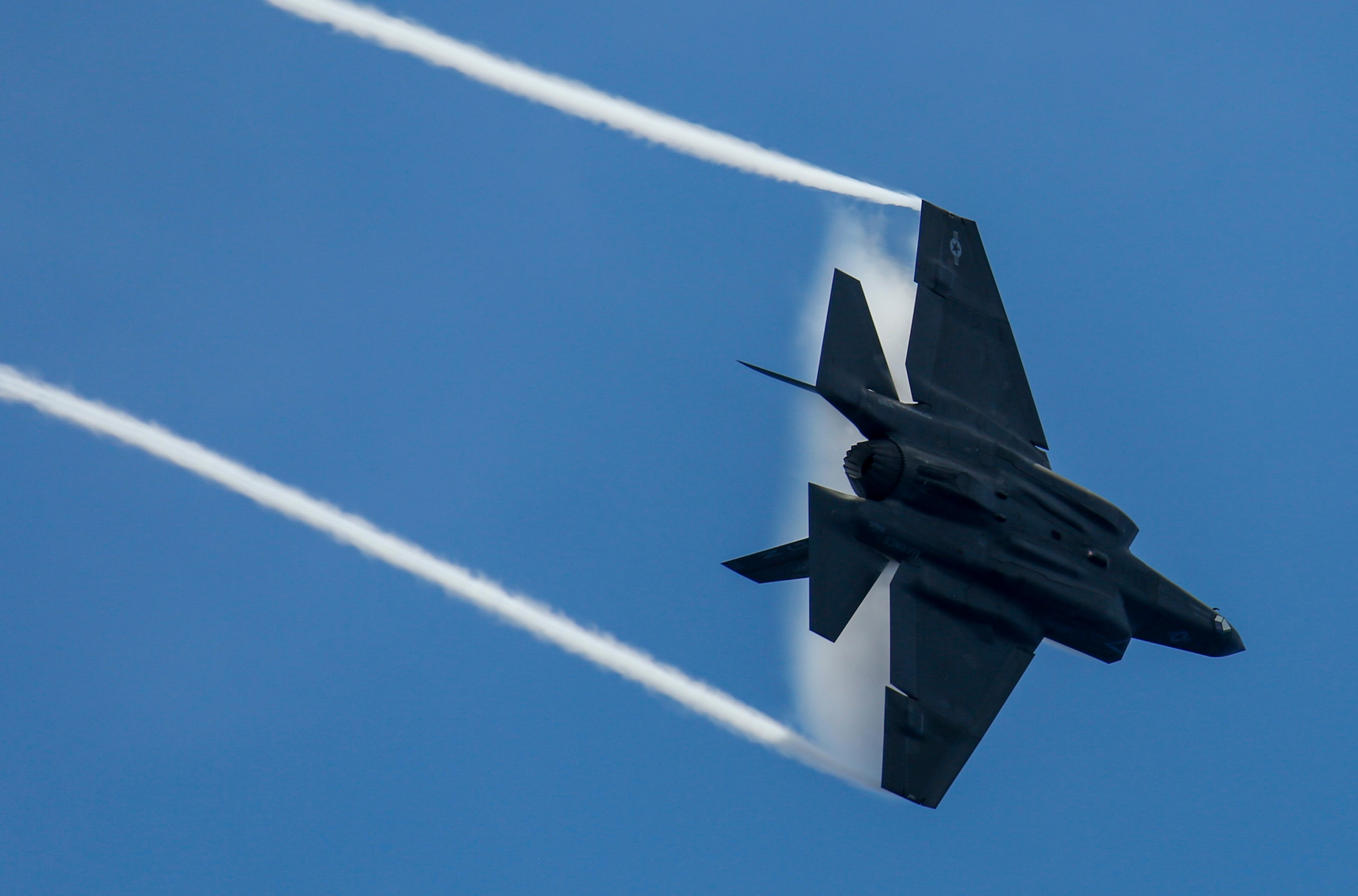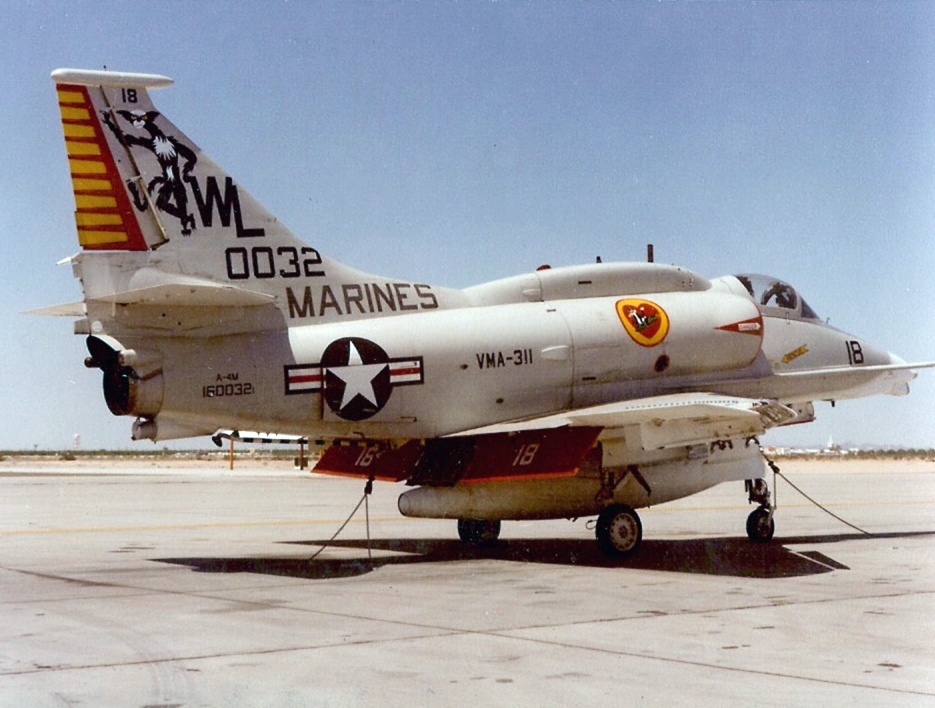
MIRAMAR MARINE CORPS AIR STATION, San Diego, Calif. — A deactivated squadron got new life as Marine Fighter Attack Squadron 311 in a Friday ceremony attended by scores of combat veterans and an F-35C Lightning II jet sporting the “Tomcats” historic squadron logo.
The Marine Corps had deactivated the “Tomcats” – it had flown the AV-8B Harrier attack jet as VMA-311 – in 2020 with plans to transition it into an F-35C squadron as part of the service’s force modernization. Its reactivation paves the way for the squadron to become fully operational with Joint Strike Fighter jets better poised to counter threats from peer adversaries’ advanced aircraft.
“Tomcats” commander, Lt. Col. Michael P. Fisher, and squadron Sgt. Maj. Janet Marrufo unfurled the squadron colors, a colorful pile of streamers pouring from the casing. The activation marks the second F-35C squadron to call Miramar home, joining the “Black Knights” of VMFA-314.
The F-35C “is unquestionably the most lethal platform that the Tomcats will fix and fly,” Col. Shannon M. Brown, Marine Aircraft Group 11, told the crowd gathered outside VMFA-314’s hangar along the flight line. While it’s the carrier variant of the F-35, “what we Marines have found is it’s the quintessential expeditionary killing machine. It has an incredible range, payload capability. It’s got brakes that stop on a dime. A tailhook to match.”
“It’s almost as if the engineers who drew up this aircraft on the drawing boards had the First Island Chain in mind when they built it,” Brown said. “And we’re very happy to have it.”
The “Tomcats” have a storied history dating back to its establishment on Dec. 1, 1942, as VMF-311. In its first wartime deployment, the squadron’s F4U Corsairs were pivotal in the island campaigns of the Pacific theater.
“It is a very rare occasion in the Marine Corps where you get to bring a unit back into the active duty ranks. It’s even more special when they carry the rich legacy and heritage that Fighting Squadron 311 does,” Brown said.
“I was in awe reading what this squadron has done over the decades,” Brown said. The squadron traveled through Miramar before flying across the Pacific into combat, “cutting their teeth by island-hopping in the Pacific and taking part in such epic battles as Okinawa.”
Long legacy

Throughout its history, the “Tomcats” provided close-air support – “our bread-and-butter mission,” Brown said – to ground forces. That included combat in Korea, where it supported the U.S. 8th Army near the Chosin Reservoir; nearly eight years of flying missions in Vietnam; the 1990-1991 Persian Gulf War; Operation Enduring Freedom in Afghanistan; and four deployments for Operation Iraqi Freedom.
Through those years, the squadron achieved several firsts as it transitioned into varying models of different airplanes, including the F4U-1 Corsair, F-80A Shooting Star, F9F2 Panther, F9F-8 Cougar, A-4 Skyhawk and AV-8B Harrier. It earned five Presidential Unit Citations – the highest honor any military unit can earn – in four different wars and 13 Navy Unit Commendations.
“It’s amazing, quite simply,” Brown said, telling the new squadron commander that “it’s that legacy that’s entrusted to you. You inherit that. And it’s not just looking back. You keep one eye on the past to remember. But you also keep one eye forward for what’s coming next.”
“You’re going to train this squadron to fight and win,” he said. “That’s what the ‘Tomcats’ are all about – to shoot down the enemy’s airplanes and to put their ships at the bottom of the ocean… We kill bad people, and we break their things.”
Looking to the east or to the west, he said, “we would see oppressive regimes actively encircling people who want to live in freedom, and that’s always been our call-to-arms,” he said, telling the new commander to “bring this squadron back to life.”
Work ahead

The “Tomcats” reactivation means more lethal capabilities for the West Coast-based I Marine Expeditionary Force. While the F-35C variants have tail hooks that enable it to operate off aircraft carriers, the “Tomcats” will focus largely on ground-based operations supporting I MEF units, Fisher said, although “we could go to the ship if needed.”
The Marine Corps’ first F-35C squadron, VMFA-314, is aligned and deployed last year with the Navy’s Carrier Air Wing 9 aboard the aircraft carrier USS Abraham Lincoln (CVN-72).
“Now we are carrying the legacy, so we want to build off all the Tomcats that came before us,” Fisher said after the ceremony, noting the newest KC-130J Hercules aircraft and VMFA-314’s F-35Cs.
“We’re going to complement the air wing that’s already out here,” Fisher said.
The F-35C variant “has the longest range and the biggest internal payload, so they can strike a target very far out,” he said. “So it’s a very lethal platform. And then now you combine the F-35 with the KC-130J – and we also have F/A-18 Hornets out there who have different capabilities and weapons systems we don’t have – so now you have a pretty lethal force combined that can stretch the battle space.”
The next months will be busy as the squadron receives additional aircraft – it’s solo F-35C had a starring role and provided a backdrop in the ceremony – receives more jets and begins training its aircrews and maintainers into a fully-operational 12-aircraft squadron.
“They will slowly start coming through the year and slowly build up,” Fisher said.
“Our message is, learn from our past. Know who we were starting off, and then we are building from there,” he added. “We have to establish the culture. We have to establish how we’re going to execute and building that Tomcat culture.”
Tomcat stories

The reactivation attracted scores of “Tomcat” veterans from over its 70-year history to join junior Marines and others for the ceremony and see the newest aircraft.
Cecil Cheeka, a former corporal and aviation ordnance Marine, traveled to San Diego from Washington state.
“Why did I make this long trip? Well, because it’s my old squadron,” said Cheeka, who served with the squadron in Vietnam during its 1967-1968 deployment.
Before the ceremony, retired Lt. Col. Duke Lind glanced at his younger self, set in a framed photo collection dating back to his Vietnam combat deployment that joined dozens of photos and wooden squadron logos set up on long tables in the hangar. Lynd donated several photos he took in Vietnam to the squadron reunion group. One photo he took was of local orphans the “Tomcats” at Bien Hoa airbase treated to ice cream one day.
Lind, who retired in 1987, was one of seven former squadron commanders who joined Fisher for the pass-and-review.
“There’s no comparison,” he said of the F-35C’s capabilities and technologies compared to the A-4s and other jets he flew during his career.
“I would have given my right arm just to know where I was,” he added. “We didn’t have the nav [navigation system] or the GPS or any of that. We were going by maps, and we had TACANs [tactical navigation systems]. But that was it.”
Lind flew Hueys during a 1967-1968 combat tour in Vietnam – he was shot down three times “and I always made it out,” he said – before he transitioned to the A-4. He was sent overseas to VMF-311, at the time in Iwakuni, Japan, and in 1972, returned to Vietnam for the Spring Offensive. Some of his young lieutenants, he said, later went on to fly combat missions during Desert Storm.
“All the airplanes they used to fly,” he said, “are in museums or in the boneyard.”





